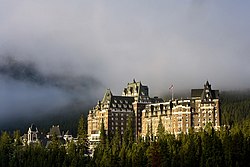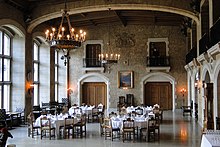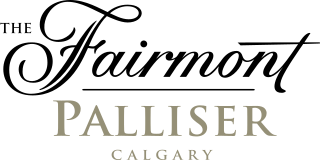
Banff National Park is Canada's oldest national park, established in 1885 as Rocky Mountains Park. Located in Alberta's Rocky Mountains, 110–180 kilometres (68–112 mi) west of Calgary, Banff encompasses 6,641 square kilometres (2,564 sq mi) of mountainous terrain, with many glaciers and ice fields, dense coniferous forest, and alpine landscapes. The Icefields Parkway extends from Lake Louise, connecting to Jasper National Park in the north. Provincial forests and Yoho National Park are neighbours to the west, while Kootenay National Park is located to the south and Kananaskis Country to the southeast. The main commercial centre of the park is the town of Banff, in the Bow River valley.
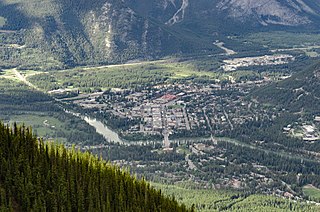
Banff is a town in Banff National Park, Alberta, Canada, in Alberta's Rockies along the Trans-Canada Highway, 126 km (78 mi) west of Calgary and 58 km (36 mi) east of Lake Louise, 1,400 to 1,630 m above sea level,

The Fairmont Hotel Vancouver, formerly and still informally called the Hotel Vancouver, is a historic hotel in Vancouver, British Columbia. Located along West Georgia Street the hotel is situated within the city's Financial District, in Downtown Vancouver. The hotel was designed by two architects, John Smith Archibald, and John Schofield. The hotel is currently managed by Fairmont Hotels and Resorts.
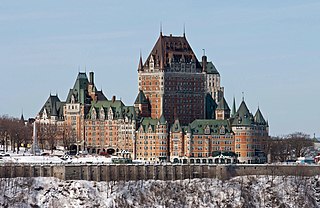
The Fairmont Le Château Frontenac, commonly referred to as the Château Frontenac, is a historic hotel in Quebec City, Quebec, Canada. The hotel is situated in Old Quebec, within the historic district's Upper Town, on the southern side of Place d'Armes. The Château Frontenac was designed by Bruce Price, and was built by the Canadian Pacific Railway company. The hotel is managed by Fairmont Hotels and Resorts.

Canadian Pacific Hotels (CPH) was a division of the Canadian Pacific Railway (CPR) that primarily operated hotels across Canada, since passenger revenue made a significant contribution to early railway profitability. CPR restructured the division as a subsidiary in 1963. In 1988, CPR purchased the Canadian National Hotels chain, making Canadian Pacific Hotels and Resorts the nation's largest hotel owner. In 1998, all CPH properties were branded as either Fairmont or Delta.
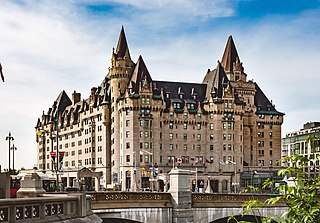
The Fairmont Château Laurier is a 660,000-square-foot (61,000 m2) hotel with 429 guest rooms in the downtown core of Ottawa, Ontario, Canada, located near the intersection of Rideau Street and Sussex Drive and designed in a French Gothic Revival Châteauesque style to complement the adjacent Parliament buildings. The hotel is above the Colonel By Valley, home of the Ottawa Locks of the Rideau Canal, and overlooks the Ottawa River. The main dining room overlooks Major's Hill Park. The reception rooms include the Wedgewood-blue Adam Room; the Laurier Room defined by Roman columns; the Empire-style ballroom and the Drawing Room featuring cream and gold plaster ornament. The hotel was designated a national historic site in 1980.

The Fairmont Chateau Lake Louise is a Fairmont hotel on the eastern shore of Lake Louise, near Banff, Alberta. The original hotel was gradually developed at the turn of the 20th century by the Canadian Pacific Railway and was thus "kin" to its predecessors, the Banff Springs Hotel and the Château Frontenac. The hotel's wooden Rattenbury Wing was destroyed by fire on 3 July 1924, and was replaced by the current Barrot Wing one year later. The Painter Wing, built in 1913, is the oldest existing portion of the hotel. The Mount Temple Wing, opened in 2004, is the most recent wing and features modern function facilities; these include the Mount Temple Ballroom.

Mount Rundle is a mountain in Canada's Banff National Park overlooking the towns of Banff and Canmore, Alberta. The Cree name was Waskahigan Watchi or house mountain. In 1858 John Palliser renamed the mountain after Reverend Robert Rundle, a Methodist invited by the Hudson's Bay Company to do missionary work in western Canada in the 1840s. He introduced syllabics there—a written language developed for the Cree, as part of his missionary work. He only visited the Stoney-Nakoda of the area around what is now called Mount Rundle in 1844 and 1847.
Fairmont Hotels & Resorts is a global chain of luxury hotel that operates more than 70 properties worldwide, with a strong presence in Canada.

The Fairmont Royal York, formerly and still commonly known as the Royal York, is a large historic luxury hotel in Toronto, Ontario, Canada. Located along Front Street West, the hotel is situated at the southern end of the Financial District, in Downtown Toronto. The Royal York was designed by Ross and Macdonald, in association with Sproatt and Rolph, and built by the Canadian Pacific Railway company. The hotel is currently managed by Fairmont Hotels and Resorts.

The Fairmont Hotel Macdonald, formerly and commonly known as the Hotel Macdonald, is a large historic luxury hotel in Edmonton, Alberta, Canada. Located along 100 Street NW, south of Jasper Avenue, the hotel is situated in the eastern end of downtown Edmonton, and overlooks the North Saskatchewan River. The 47.7-metre-high (156 ft) hotel building was designed by Ross and MacFarlene and contains eleven floors. The hotel is named for the first prime minister of Canada, Sir John A. Macdonald.

The Algonquin Resort is a Canadian coastal resort hotel in the Tudor Revival style, located in St. Andrews, New Brunswick. An architectural icon of New Brunswick, the hotel is the most famous symbol of St. Andrews and one of the most photographed buildings in the province.

The Fairmont Empress, formerly and commonly referred to as The Empress, is one of the oldest hotels in Victoria, British Columbia, Canada. Located on 721 Government Street, it is situated in Downtown Victoria, facing the city's Inner Harbour. The hotel was designed by Francis Rattenbury, and was built by Canadian Pacific Hotels, a division of the Canadian Pacific Railway company. The hotel is presently managed by Fairmont Hotels and Resorts, part of AccorHotels since 2016. It is owned by Nat and Flora Bosa of Vancouver.

Châteauesque is a Revivalist architectural style based on the French Renaissance architecture of the monumental châteaux of the Loire Valley from the late fifteenth century to the early seventeenth century.

The Delta Hotels Bessborough, formerly and commonly known as the Bessborough, is a historic hotel in Saskatoon, Saskatchewan, Canada. The hotel is within the Central Business District, a commercial district in Saskatoon. The Bessborough was designed by Archibald and Schofield for Canadian National Hotels, a division of Canadian National Railway.

The Jasper Park Lodge is a 442-room hotel situated on 700 acre site along Lac Beauvert in Jasper National Park, Alberta, Canada. The hotel was established in 1921 by Canadian National Railway and is one of Canada's grand railway hotels.

The Fairmont Le Château Montebello, formerly and commonly known as the Château Montebello, is a historic hotel and resort complex in Montebello, Quebec, Canada. The resort complex includes a large game reserve and a large wooden structure. The wooden hotel structure was developed by Victor Nymark.

Canada's grand railway hotels are a series of railway hotels across the country, each a local and national landmark, and most of which are icons of Canadian history and architecture; some are considered to be the grand hotels of the British Empire. Each hotel was originally built by the Canadian railway companies, or the railways acted as a catalyst for the hotel's construction. The hotels were designed to serve the passengers of the country's then expanding rail network, and they celebrated rail travel in style.
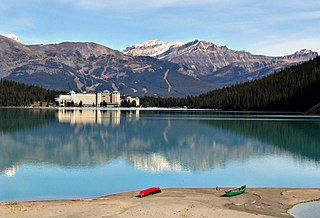
Lake Louise is a glacial lake within Banff National Park in Alberta, Canada. Situated 11 km (6.8 mi) east of the border with British Columbia, Lake Louise is located 5 km (3.1 mi) west of the hamlet of Lake Louise and the Trans-Canada Highway.
